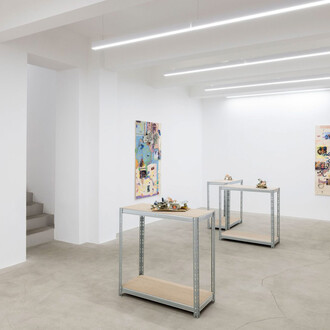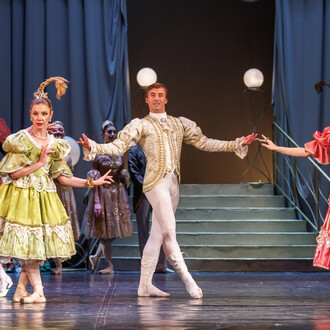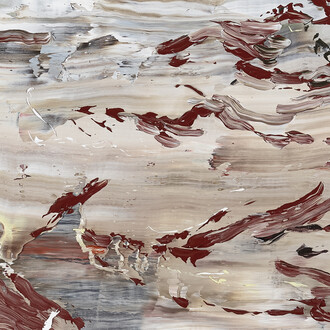On Monday 20 October, on the occasion of Olmo Erba's solo exhibition, Amy-d Arte Spazio gallery in Milan will become Putridarium, a non-place where contemporary aesthetics and narratives on medieval practices become metamorphoses of the body and space.
On display are previously unseen works such as Orante, Fiorito, Granduca della fogna and Spauracchio from the series Il culto delle stelle, 2025 (The cult of the stars, 2025), four oil paintings on flexoid from the series Miracolo di San Ulrico, 2025 (Miracle of St. Ulrich, 2025), pencil and ink works on paper such as Senza titolo (Bosco) (Untitled (Forest)) from 2020 and Dolcino Bruciato, 2023 (Burnt Dolcino, 2023), watercolour on Fabriano paper from 2023. The research of Olmo Erba (Bergamo, Italy, 1997) is similar to the restitution and examination of the not yet vanished forms of a dream that has just ended, in an ongoing dialogue with the past and its shadows by means of the rituality of a soiled archaeology, aimed at reinterpreting the tragicomic nature of figures and symbols drawn from art history, literature and popular tradition. It is a movement akin to the attitude of a grave robber or necromancer who, with irreverent reverence, digs up, exhumes or unearths the repressed from eras that do not belong to him: as history has gone into a loop, biting its own tail in the circularity of an eternal present, artists are allowed to extend their range of action not only in space but also in time, to cut out and shorten the zeitgeist of different eras in their own image and likeness.
The Middle Ages, in particular, become both the key to unlocking the germinal substratum of Western culture and the antidote through which to exert a salvific influence of Jungian tradition upon it, countering contemporary nihilism with the idea of an orderly cosmos aimed at an ultimate goal, the stability of the home against the prevailing class struggle, and harmony with natural cycles against the age of neurosis. “Putridarium” refers to a place of fermentation and germination, similar in shape to a crypt and used for the temporary display of the putrefactive process of the mortal remains of monks and nuns, placed on stone thrones equipped with a drainage hole: a place capable of directly linking liquefaction and ascension, anabasis, catabasis and, above all, catharsis from the superfluous, blending the sacredness and folklore of putrefaction into a homogeneous mixture that explores the profound mysticism embedded in the alchemy of human (de)composition.
Through a heterogeneous body of works that combines traditional and new materials, the exhibition invites visitors to immerse themselves and flounder in the murky depths of an underground, muddy, regurgitating imagination, like a bittersweet fairy tale, reminiscent of a lost but ever-present and latent time, ready to re-emerge thanks to the serpentine dance of symbols.
The Middle Ages and the contemporary world. Two incompatible worlds?
Not at all, at least in the visual arts.
This is the thesis underlying Alexander Nagel's book Medieval modern: art out of time, published in 2012. Nagel does not follow a chronological approach and explains why: as he argues, some aspects of recent art history are simply not revolutionary at all.
The vocabulary used by the main media and opinion makers – even when it comes to scholars and intellectuals who are not medievalists – push the Middle Ages (and related adjectives) into the realm of negative meanings. Middle Ages, medieval and all the possible variations, in short, appear to be synonymous with reactionary, archaic, badly biased by religious factors, intolerant, disrespectful of individual conscience and so on. The widespread common sense views the Middle Ages with suspicion or morbid wishful thinking, cannibalising historical knowledge by biting away at its complexities and ultimately trapping the “mental travellers” who, at the beginning of their journey à rebours, believed they were setting their compass on the past. It is quite clear how much this interest in the centuries that are universally defined as dark – often in total ignorance of them – can be stimulated by proposals. “The world is heading towards a new Middle Ages”, wrote British political scientist Hedley Bull in the late 1970s, in his famous essay entitled The anarchical society.
The desire to keep the Middle Ages “dark” so that it forms a black backdrop upon which to highlight – as has been so authoritatively written – “the paradigm of Modernity”. Perhaps even an artistic expression that appears to be very distant from the main context, such as Ridley Scott's famous film Blade runner (1982), a free film adaptation of Philip K. Dick's Do androids dream of electric sheep?, is not exempt from this cultural wave, as a masterful Middle Ages appears in the film – a near future capable of imprinting itself on the conscience with a persistence that is nothing short of scathing. The Middle Ages of the black legend is – in fact and in essence – a business.
This is the open source Middle Ages, no longer the rarefied atmosphere of investigation by a few specialists but a commercial proposition by the omnivorous world of communication, perhaps a reaction to the focus on the contemporary that has now come to marginalise the recent and distant past within increasingly narrow confines, even in school education. This medievalising trend – which until a few years ago was interpreted by many social commentators as evidence of an elusive/subversive tendency to escape into the irrational – is nevertheless an expression of a curiosity that calls for more accessible answers than those provided by the academic world. To acknowledge that artistic objects have a hybrid identity and can be studied based on ideas, practices and needs that have been in place since at least the Middle Ages is a valuable insight for understanding how the proclaimed discontinuity between the medieval and the contemporary, between two different conceptions of art, is the outcome of a rootless narrative. The challenge entrusted to these quick pages is precisely this: to analyse a phenomenon while trying to abstract oneself from the superfluous pedantry of judgement.
Experimentation as a design code and responsibility to open up new possibilities of meaning. With Putridarium, Amy-d Arte Spazio gallery, together with the economArt platform, renews its interest in the experimentation carried out by young and little-known artists, opening up to smart exhibitions where the focus is on the process of conception and creation rather than on the artefact itself. The space itself is designed to be a fluid “third place” at the service of imagination, art and storytelling, with the ability and courage to expose itself.
















